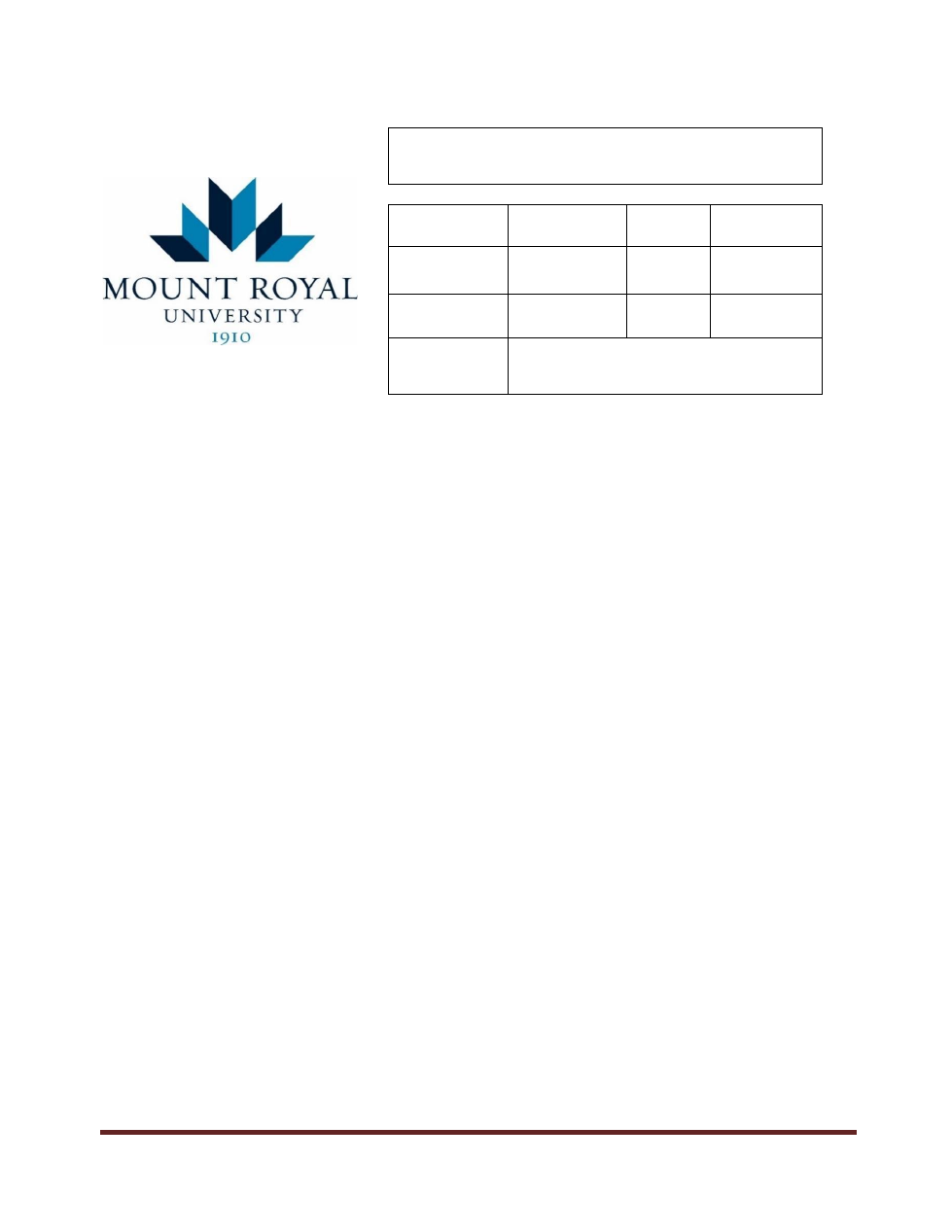
Page 1 of 4
Emergency and Continuity Management Policy
– May 28, 2024
EMERGENCY
AND
CONTINUITY
MANAGEMENT
POLICY
Policy Type:
Management
Initially
Approved:
May 28, 2024
Policy Sponsor:
General Counsel
and University
Secretary
Last
Revised:
Primary Contact:
Chief Safety, Risk
and Employee
Wellness Officer
Review
Scheduled:
May 28, 2029
Approver:
Board of Governors
A.
OVERVIEW
Mount Royal University (the “University”) recognizes that Emergencies and Disruptions can
profoundly impact the ability of the University to achieve its mission. Emergency and Continuity
Management enables the University to maintain delivery of teaching and learning experiences and
strengthen the Mount Royal University community.
B.
PURPOSE
This Policy outlines the principles and framework required for a comprehensive and integrated
Emergency and Continuity Management program at the University.
C.
SCOPE
This Policy applies to all members of the University community.
D.
POLICY STATEMENT
1.
GENERAL PRINCIPLES
1.1
The Department of Safety, Risk and Employee Wellness will provide subject
matter expertise and advice in matters relating to Emergency and Continuity
Management across the University.
1.2
Emergency and Continuity Management activities at the University are prioritized
to:
a. Minimize loss of life, injury, and property damage;
b. Protect critical facilities, equipment, records, and assets;
c. Mitigate the duration and severity of Disruptions due to an Emergency;
and
d. Ensure continuity or timely resumption of Critical Functions.
2.
EMERGENCY AND CONTINUITY MANAGEMENT PROGRAM
2.1
The Emergency and Continuity Management Program is aligned with and
supports the
University’s values and goals and as such, the implementation
and maintenance of the Program are institutional priorities.

Page 2 of 4
Emergency and Continuity Management Policy
– May 28, 2024
2.2
The University maintains an Emergency and Continuity Management
Program that defines the administrative structures and processes to
manage Emergencies and Disruptions, in alignment with Canadian
Standards Association (CSA) Z1600 standard and industry best practices.
The Program comprises the following elements:
a. Prevention and Mitigation, including Hazard identification and Risk
assessments, and the development of strategies to prevent or mitigate the
impact of Incidents, Emergencies and Disruptions.
b. Preparedness, through the development and maintenance of an
institutional Emergency and Continuity Management Plan
(“the Plan”) that
includes:
i.
defined Emergency thresholds and
notification/escalation procedures;
ii.
assignment of roles, responsibilities, accountabilities,
and levels of authority during Response activities;
iii.
plans for timely and effective communications
during an Emergency, including emergency
notification and crisis communications plans;
and
iv.
Emergency awareness and education for all
members of the campus community.
c. Response, which includes all actions taken during or immediately after
an Emergency to manage its consequences, including internal and
external communications to University stakeholders. These actions form
a continuum from immediate Response to Recovery and follow the
Emergency and Continuity Management priorities. Incident and
Emergency Response structures are scalable and adaptable to individual
scenarios. These structures include the Incident management team and
the Emergency Operations Centre (EOC) team.
i.
The Incident management team is responsible for on-site
tactical management of Incidents and Emergencies and
notifying the EOC Director of an Emergency that requires
or may require EOC activation.
ii.
The Emergency Operations Centre (EOC) team is
responsible for the direction and control of Emergency
Management activities at the strategic level, including:
1. assuming authority with regard to strategic
decision making, resource and budget
allocation, and communications approval
as they pertain to the Emergency; and
2. assuming EOC-specific roles and
responsibilities that are independent of and
distinct from each individual’s day-to-day
University operational role.
d. Recovery, which includes activities designed to return conditions to a
level acceptable to the University following an Emergency. Recovery
activities may include:
i.
planning for the resumption of services and activities not
maintained during the Response;

Page 3 of 4
Emergency and Continuity Management Policy
– May 28, 2024
ii.
communicating with University stakeholders; and
iii.
conducting Recovery assessments, re-evaluating plans,
and updating documentation accordingly.
DEFINITIONS
(1)
Continuity management
an integrated process involving the development and
implementation of activities that provides for the
continuation and/or recovery of critical service delivery
and business operations in the event of a disruption.
(2)
Critical Function(s)
a process, service, or activity normally performed by a
department or faculty that, if disrupted, risks immediate
adverse effect(s) in terms of loss of life, personal injury,
loss of property, and/or the University’s ability to
maintain services essential to its mission.
(3)
Disruption(s)
an interruption of normal operations or processes.
(4)
Emergency(ies)
a present or imminent event that requires prompt
coordination of actions concerning persons or property
to protect the health, safety, or welfare of people or to
limit damage to property or the environment.
(5)
Emergency management
an ongoing process to prevent, mitigate, prepare for,
respond to, and recover from an incident.
(6)
Executive Leadership Team
the President, Vice-Presidents, and other support staff
as deemed necessary.
(7)
Hazard(s)
a potentially damaging physical event, phenomenon, or
human activity that could cause the loss of life or injury,
property damage, social and economic disruption, or
environmental degradation.
(8)
Incident(s)
a situation that might be, or could lead to, a disruption,
loss, or emergency.
(9)
Mitigation
the actions taken proactively to reduce the Risks and
impacts posed by incidents.
(10) Plan
the Emergency and Continuity Management Plan
(11) Policy
the Emergency and Continuity Management Policy
(12) Preparedness
measures taken in advance of an incident to ensure an
effective response and recovery.
(13) Prevention
measures taken to avoid an incident or stop it from
occurring.
(14) Program
the Emergency and Continuity Management Program

Page 4 of 4
Emergency and Continuity Management Policy
– May 28, 2024
(15) Recovery
activities and programs designed to return conditions to
a level that is acceptable to the University following an
emergency.
(16) Response
the actions taken during or immediately after an
emergency or significant business disruption for the
purpose of managing the consequences.
(17) Risk
is the effect of uncertainty on objectives.
(18) University
means Mount Royal University.
E.
RELATED POLICIES
● Contractual Signing Authority Policy
● Enterprise Risk Management Policy
● Environmental Health and Safety Policy
F.
RELATED LEGISLATION
● Occupational Health and Safety Act, Alberta
● Occupational Health and Safety Code, Alberta
G.
RELATED DOCUMENTS
● Emergency Management Procedure
● Canadian Standards Association (CSA) Group Z1600-17: Emergency and
continuity management program
H.
REVISION HISTORY
Date
(mm/dd/yyyy)
Description of
Change
Sections
Person who
Entered Revision
(Position Title)
Person who
Authorized
Revision
(Position Title)
New Policy
Board of Governors



